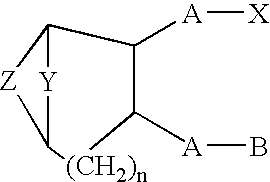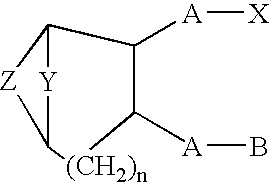Thromboxane ligands without blood clotting side effects
a thromboxane and receptor technology, applied in the field of thromboxane receptor ligands, can solve problems such as vision impairment, and achieve the effect of increasing intraocular pressure and reducing intraocular pressur
- Summary
- Abstract
- Description
- Claims
- Application Information
AI Technical Summary
Benefits of technology
Problems solved by technology
Method used
Image
Examples
example 1
Cyclopentane Heptenoic Acid, 5-Cis-2-(3α-t-Butyldimethyl-Silyloxy-1-Trans-Octenyl)-3,5-Dihydroxy, [1α, 2β, 3α, 5α]Methyl Ester
[0066]PGF2α (542 mg, 1.53 mmol) was dissolved in ethylether (Et2O) (20 mL) and cooled to 0° C. A solution of CH2N2 in Et2O was added dropwise to the above suspension until a yellow color persisted. The solution was warmed to 25° C. for 0.5 h and then concentrated in vacuo to yield PGF 2α methyl ester as an oil.
[0067]The crude ester was heated at reflux with n-butyl boronic acid (0.188 g, 1.84 mmol) in CH2Cl2(3.1 mL) for 2 h. The volatiles were removed under vacuum to yield the crude boronate ester which was immediately diluted with CH2Cl2 (3 mL) and cooled to 0° C. 2,6-Lutidine (0.43 mL, 3.7 mmol) was added followed by t-butyldimethylsilyl trifluoromethane-sulfonate (0.67 mL, 2.9 mmol). The reaction solution was then warmed to 23° C. for 16 h, concentrated, and rediluted with methanol (40 mL). After stirring for 24 h, the methanol was removed under vacuum and...
example 2
7-[6-Carbomethoxy-2-Cis-Hexenyl]-6-[3α-t-Butyldimethylsilyloxy-1-Trans-Octenyl]-3-Oxo-2,4-Dioxobicyclo[3.2.1]Octane
[0068]149 mg (0.318 mmol) of the compound of Example 1 were dissolved in 1.6 ml of CH2Cl2 and cooled to at −78° C. 0.154 mL (0.6 mmol) of pyridine were then added and stirring was continued for 5 minutes. 48 mg (0.5 mmol) of triphosgene dissolved in 1 mL CH2Cl2 was slowly added and the resulting mixture was stirred for an additional hour before being allowed to slowly warm to room temperature. After standing overnight the reaction was quenched with saturated aqueous NH4Cl, diluted with EtOAc and the resulting reaction mixture was worked up washing the organic portion with 1 N HCl, NaHCO3 and brine. The organic layer was dried over anhydrous MgSO4, filtered and concentrated in vacuo to yield 149 mg of a crude fraction including the named compound.
example 3
7-[7-Hydroxy-2-Cis-Hyptenyl]-6-[3α-t-Butyldimethylsilyloxy-1-Trans-Octenyl]-3-Oxo-2,4-Dioxobicyclo[3.2.1]Octane
[0069]73 mg (0.143 mmol) of the compound of Example 2 were dissolved in a 0.28 mL of ethylether (Et2O) and then 3.0 mg of lithium borohydride (LiBH4) were added and the mixture stirred at 23° C. overnight. The reaction was quenched using 2.0 N NaOH and the resulting reaction mixture was worked up by extraction with EtOAc and washing the organic portion with brine. The resulting organic layer was concentrated in vacuo and dried over anhydrous MgSO4 to yield 63 mg of the named compound.
PUM
| Property | Measurement | Unit |
|---|---|---|
| volume | aaaaa | aaaaa |
| temperature | aaaaa | aaaaa |
| weight | aaaaa | aaaaa |
Abstract
Description
Claims
Application Information
 Login to View More
Login to View More - R&D
- Intellectual Property
- Life Sciences
- Materials
- Tech Scout
- Unparalleled Data Quality
- Higher Quality Content
- 60% Fewer Hallucinations
Browse by: Latest US Patents, China's latest patents, Technical Efficacy Thesaurus, Application Domain, Technology Topic, Popular Technical Reports.
© 2025 PatSnap. All rights reserved.Legal|Privacy policy|Modern Slavery Act Transparency Statement|Sitemap|About US| Contact US: help@patsnap.com



